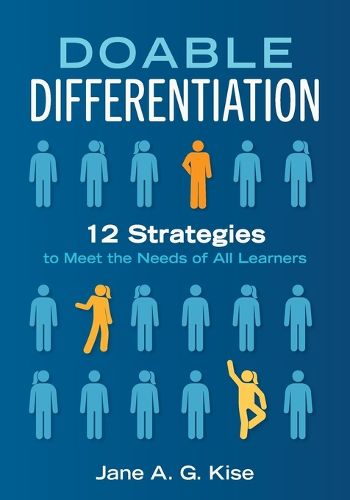Readings Newsletter
Become a Readings Member to make your shopping experience even easier.
Sign in or sign up for free!
You’re not far away from qualifying for FREE standard shipping within Australia
You’ve qualified for FREE standard shipping within Australia
The cart is loading…






This title is printed to order. This book may have been self-published. If so, we cannot guarantee the quality of the content. In the main most books will have gone through the editing process however some may not. We therefore suggest that you be aware of this before ordering this book. If in doubt check either the author or publisher’s details as we are unable to accept any returns unless they are faulty. Please contact us if you have any questions.
Differentiating for students’ learning preferences can often seem too complex and complicated for too little gain. Learn a better way forward with the guidance of Doable Differentiation. Author Jane A. G. Kise provides a series of straightforward, high-reward strategies that K-12 educators like you successfully use in their daily practice to support, engage, and challenge students with diverse learning styles.
Understand the benefits of differentiation and how to implement differentiated instruction simply and effectively. Learn students’ preferred cognitive processing styles to better tailor differentiated lesson plans for all learners’ needs. Discover 12 categories of research-based differentiation strategies to implement immediately. Provide students with a variety of accessible options for processing information, engaging in higher-level thinking, and demonstrating learning. Engage learners and develop their proficiency and self-efficacy.
Contents:
Introduction: What Makes Differentiation Doable?
Part 1: The Foundation
Chapter 1: Cognitive Processes and Effective Differentiation
Chapter 2: Clear Learning Goals and Expectations
Part 2: The Strategies
Chapter 3: Choice
Chapter 4: Wait Time
Chapter 5: Unambiguous Instruction
Chapter 6: Pressure-Prompted Accommodations
Chapter 7: Student-Centered Discussions
Chapter 8: Curiosity Creators
Chapter 9: Open Questions
Chapter 10: Concept Maps
Chapter 11: Big Notes
Chapter 12: Moveable Organizers
Chapter 13: Planned Movement
Chapter 14: Talking to Write
Part 3: Lesson Planning
Chapter 15: Two-Step Differentiation
Epilogue
References and Resources
Index
$9.00 standard shipping within Australia
FREE standard shipping within Australia for orders over $100.00
Express & International shipping calculated at checkout
Stock availability can be subject to change without notice. We recommend calling the shop or contacting our online team to check availability of low stock items. Please see our Shopping Online page for more details.
This title is printed to order. This book may have been self-published. If so, we cannot guarantee the quality of the content. In the main most books will have gone through the editing process however some may not. We therefore suggest that you be aware of this before ordering this book. If in doubt check either the author or publisher’s details as we are unable to accept any returns unless they are faulty. Please contact us if you have any questions.
Differentiating for students’ learning preferences can often seem too complex and complicated for too little gain. Learn a better way forward with the guidance of Doable Differentiation. Author Jane A. G. Kise provides a series of straightforward, high-reward strategies that K-12 educators like you successfully use in their daily practice to support, engage, and challenge students with diverse learning styles.
Understand the benefits of differentiation and how to implement differentiated instruction simply and effectively. Learn students’ preferred cognitive processing styles to better tailor differentiated lesson plans for all learners’ needs. Discover 12 categories of research-based differentiation strategies to implement immediately. Provide students with a variety of accessible options for processing information, engaging in higher-level thinking, and demonstrating learning. Engage learners and develop their proficiency and self-efficacy.
Contents:
Introduction: What Makes Differentiation Doable?
Part 1: The Foundation
Chapter 1: Cognitive Processes and Effective Differentiation
Chapter 2: Clear Learning Goals and Expectations
Part 2: The Strategies
Chapter 3: Choice
Chapter 4: Wait Time
Chapter 5: Unambiguous Instruction
Chapter 6: Pressure-Prompted Accommodations
Chapter 7: Student-Centered Discussions
Chapter 8: Curiosity Creators
Chapter 9: Open Questions
Chapter 10: Concept Maps
Chapter 11: Big Notes
Chapter 12: Moveable Organizers
Chapter 13: Planned Movement
Chapter 14: Talking to Write
Part 3: Lesson Planning
Chapter 15: Two-Step Differentiation
Epilogue
References and Resources
Index